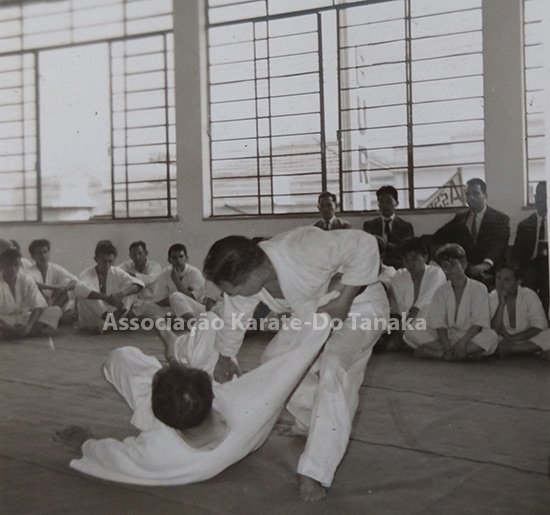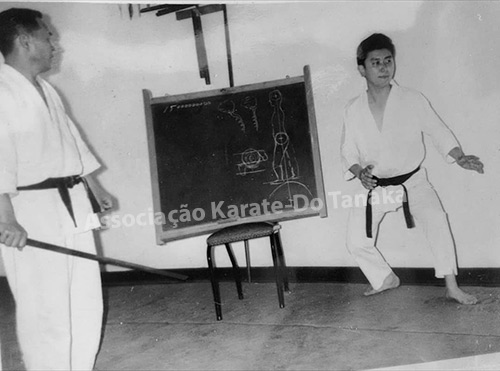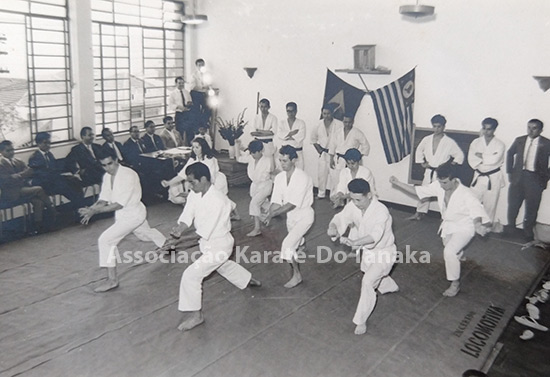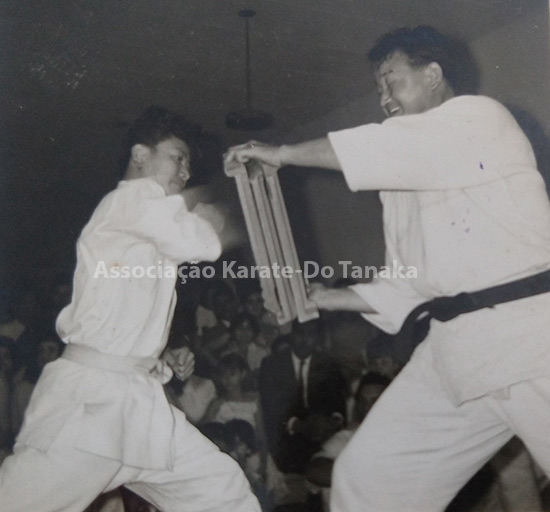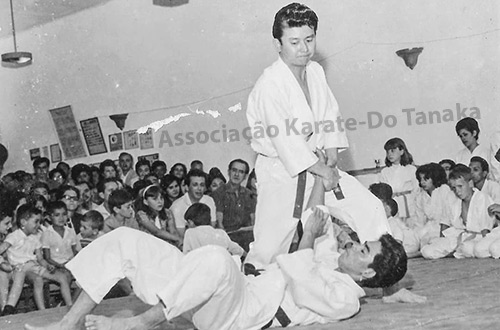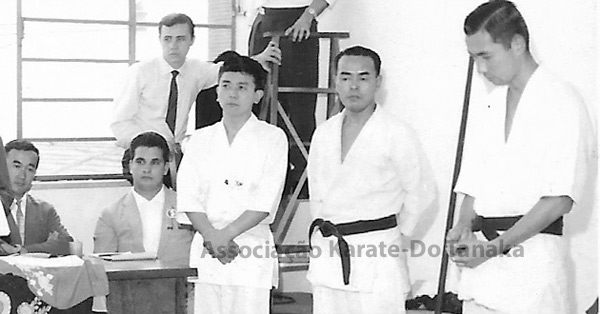
Tsunioshi Tanaka and Seiichi “Shikan” Akamine
The Tanaka Karate-Do Association (Associação Karate-Do Tanaka) is one of the oldest Karate organizations in Brazil. It is also one of the most long-lived, perhaps only behind Shinshukan, by master Yoshihide Shinzato, founded a year earlier, in 1962. For its history of pioneering, determination and loyalty to the values of Karate, the history of our school needs to be widely known and recognized. Many active Karate teachers today, even though they are in other styles like Shotokan, Kyokushin and Seido Juku, started their trajectory in our organization or in affiliated dojos, which only proves the importance of the Association for Brazilian Karate.
Evidently, the main credit of this fruitful trajectory is from the founder of the Tanaka Karate-Do Association, Tsunioshi Tanaka (Lins, 1934 – São Paulo, 2017), who dedicated more than five decades to the study, practice, teaching and dissemination of Karate. He was the son of Masayoshi Tanaka and Tomo Tanaka, Japanese immigrants from the city of Masuda, in Shimane province, who disembarked with relatives at the port of Santos in 1931 to work in the fields in the interior of São Paulo. He was the second of six brothers. He first learned the values cultivated in martial arts from his father, who was a Kendo instructor in his homeland, and he implemented these values throughout his life.
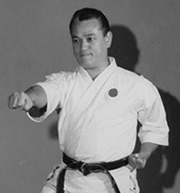
Juichi Sagara
The history of the Tanaka Karate-Do Association begins in the early 1960s, a period when some pioneering Karate masters, newcomers from Japan, were taking their first steps to spread their martial art. At the same time, Tsunioshi Tanaka worked in the watchmaking profession and had a store in the Vila Prudente neighborhood, in the city of São Paulo. One day, in 1962, he was visited in his shop by a Japanese man who sold knickknacks and who invited him to train Karate. That person was the late master of Shotokan Juichi Sagara (Tokyo, 1934 – São Paulo, 2001).
Upon the invitation, Tanaka was apprehensive about the possibility of hurting his fingers in a Karate training, as his profession in watch maintenance would be impaired in this case, but Sagara guaranteed that there would be no problem. So our teacher took some classes with Sagara Sensei and even helped him get members together for his organization. Due to some mishaps, Tanaka did not continue as a student of Sagara and ended up going to train under the guidance of another important figure of Brazilian Karate: the master Shikan Akamine (Naha, 1920 – São Paulo, 1995).
Born in Okinawa, Seiichi Akamine (stage name in Japanese Yoshitaka or Chinese Shikan) is considered the introducer of the Goju-Ryu style in Brazil, despite having a slightly different curriculum from the more traditional schools of this lineage. Some sources say he had contacts with masters of the Shuri-Te lineage, such as Chomo Hanashiro, Kentsu Yabu and Chotoku Kyan; besides having trained with Seiko Higa, Kanki Izumikawa and Kanbun Uechi. He was also friends with Seiken Shukumine (Gensei-Ryu). In addition to its legacy continuing in schools in Goju-Ryu, such as Ken In Kan, there are disciples who maintained a style created by Akamine, known as Shikan-Ryu or Kenshin-Ryu.

Masters Hanashiro, Yabu, Kyan, Higa, Izumikawa and Uechi
Akamine had founded, in 1959, the first Karate school legally established in the country, the Brazilian Karate Association (Associação Brasileira de Karate – ABK), which was headquartered at Rua Tabatinguera, in the Sé neighborhood, downtown São Paulo. There, a meeting took place with Tanaka and a group of people interested in starting a dojo in the neighborhood of Vila Prudente. At the meeting, it was agreed that one of ABK’s students, Sadao Saito (who died in 1992), would be responsible for the regular training of the new group, under Akamine’s supervision.
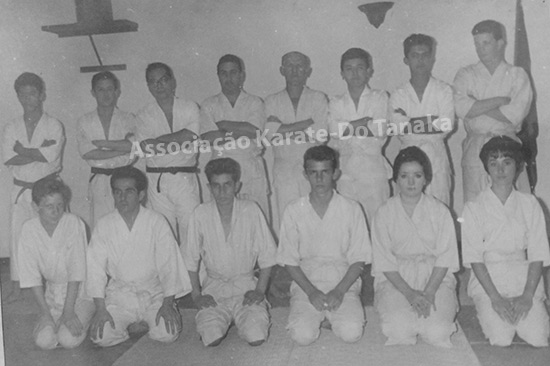
Sadao Saito (3rd in foot from left to right) and students from São Paulo Karate Association
Other members of ABK also participated in the classes and events of this dojo that was being created, such as Sergio Yanagizawa and Ryuzo Watanabe. Initially the training was done in a salon inside a warehouse at the Antarctica beverage factory, located at Coelho Neto Street. Subsequently, a definitive space was rented, at Rua Capitão Pacheco e Chaves Street, No. 1.063, which is still our Hombu Dojo to this day.
Enthusiastic about Karate training, Tsunioshi Tanaka, along with several members with whom he had been practicing officially founded on May 23, 1963 the São Paulo Karate Association (Associação Paulista de Karate), linked to ABK. Years later the São Paulo Karate Association would be renamed Tanaka Karate-Do Association.
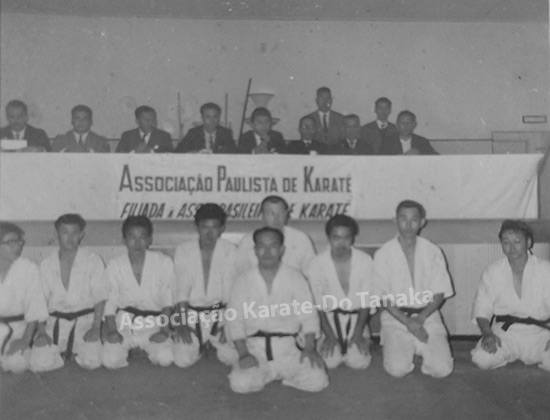
Shikan Akamine and ABK members
The dojo has developed over the months. In reports from that time, Master Tanaka said that on many occasions teacher Sadao Saito asked him to lead the training when he was unable to attend. This responsibility helped him to develop fast and motivated him to practice hard.
At the end of 63, thanks to his dedication to training, master Tanaka was promoted to black belt shodan by master Akamine. Tanaka Sensei stated that at the time he did not consider his graduation a cause for celebration, as he understood that he had a lot to study and learn, so he took this as a motivation to work even harder in Karate. This trait of always wanting to go deeper and understand his martial art was decisive for the direction of the Association.

Tsunioshi Tanaka receiving the black belt
Apparently for political reasons, in 1965 the master Shikan Akamine was dismissed from the Brazilian Karate Association. In solidarity with him, our master Tsunioshi Tanaka and other members of the São Paulo Karate Association also decided to leave this entity.
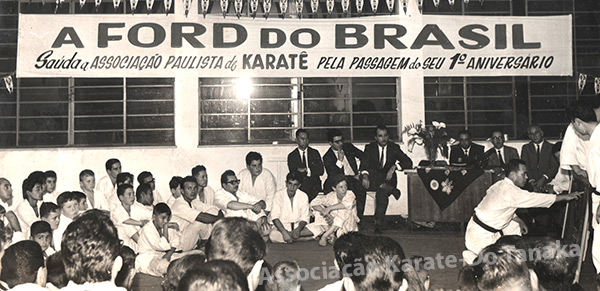
First anniversary of the São Paulo Karate Association (1964)
With the departure of ABK, Tanaka looked for ways to continue developing his Karate and his dojo. Still in 1965, he got in touch with master Masutatsu Oyama, founder of the Kyokushin style, which started a new and crucial phase of the São Paulo Karate Association, which will be covered in the next article on the history of our organization.
PHOTOS:






